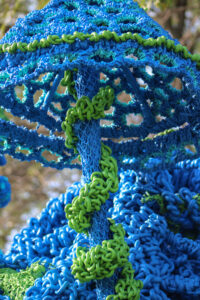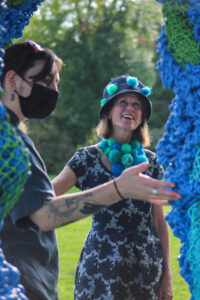The unveiling of a new sculpture on the USM Portland Campus
By Caraline Squires | Staff Writer
 If you’ve been on the north side of the Portland campus, behind McGoldrick, you’ve probably seen TANGLE. Approximately 14 ft. tall by 10 ft. across and over 2000 pounds, TANGLE is made of discarded fishing nets, rope, and steel. What is it? That’s the best part. Creators of the creature, Pamela Moulton and Roy Fox, explain that the work’s genius resides in the fact that it is unclear what TANGLE is. The work actively resists categorization and represents that the more chaotic the world is, the more people search for boundaries and paths untaken.
If you’ve been on the north side of the Portland campus, behind McGoldrick, you’ve probably seen TANGLE. Approximately 14 ft. tall by 10 ft. across and over 2000 pounds, TANGLE is made of discarded fishing nets, rope, and steel. What is it? That’s the best part. Creators of the creature, Pamela Moulton and Roy Fox, explain that the work’s genius resides in the fact that it is unclear what TANGLE is. The work actively resists categorization and represents that the more chaotic the world is, the more people search for boundaries and paths untaken.

Moulton, who found a four-leaf clover before introducing the fantastical creature on Sept. 12, explained that the most difficult part of working with TANGLE was space – getting it in and out of buildings was difficult. Moulton and Fox gave a special thanks to Lights Out Gallery in Norway Maine, a non-profit whose mission is to “connect Maine artists and their circles to a broader community.”
President Edmundson spoke and gave a special thanks to those involved in the process, “Public art is so important for so many reasons,” said Edmundson. Not only does public art benefit the campus, but it also encourages dialogue. 
The materials used to bring TANGLE to life were salvaged from the Gulf of Maine and represent a part of Maine history that long outlives the state’s dependency on the fishing industry. The Wabanaki, or “People of The Dawn,” have fished the coasts of Maine for over 12,000 years. Moulton and Fox gave the discarded material a new life that inspires dialogue about Maine’s fishing industry; its beginnings with the Wabanaki people and its uncertain future as the effects of climate change worsen.
